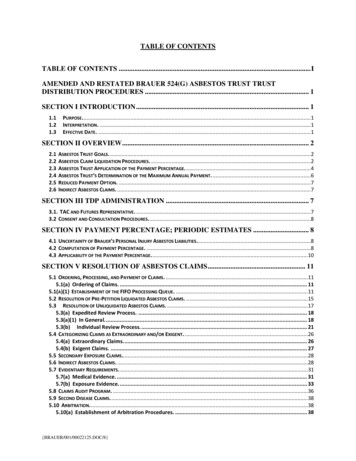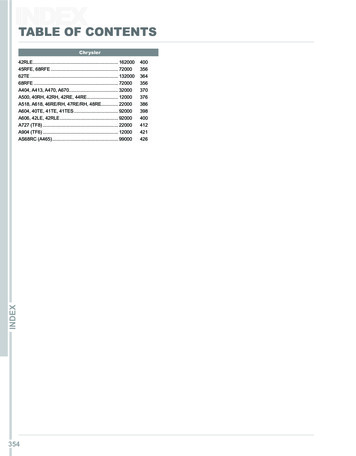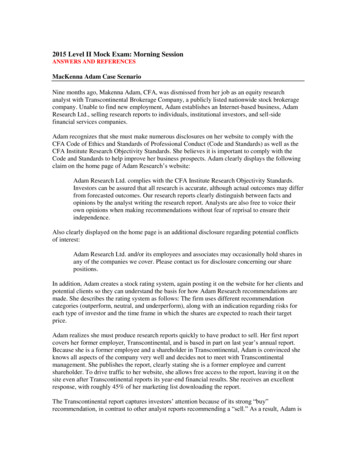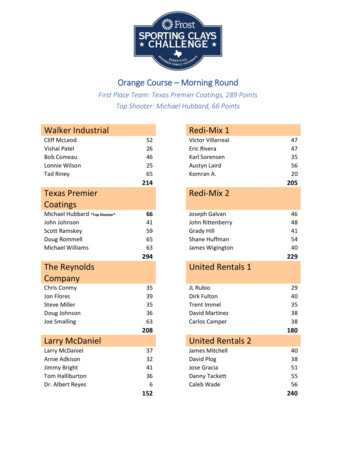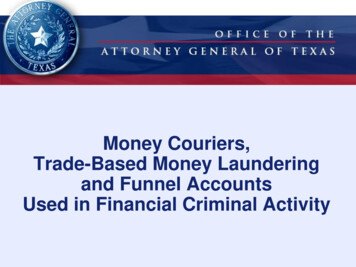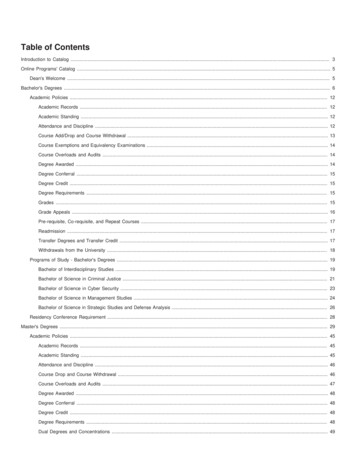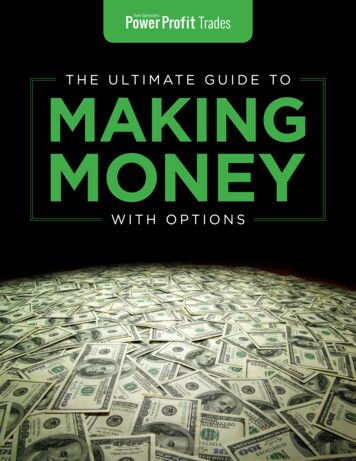
Transcription
Table of ContentsIntroduction1You’re On Your Way to Financial IndependenceChapter 12The Moneymaking Power of OptionsChapter 25Setting Up Your Options AccountChapter 38How to Trade OptionsChapter 412How to Pick the Best Option for You, Every TimeChapter 5How to Lower Your Risk When Trading OptionsChapter 61926Options Trading Tips You Can’t Get Anywhere ElseChapter 7Placing Your First Trade33
Introduction:You’re on Your Way to Financial IndependenceDear Reader,You’ve just taken a huge step toward living a wealthy life.Until now, you’ve been settling for mediocre returns. You’ve been watching yourportfolio grow 5%, 8%, maybe 10% a year if you’re lucky. But that’s not nearly what youcould be making.And this is on top of giving away more money than you should to taxes, brokercharges, banking costs. It’s death by a thousand fees. But it doesn’t have to be that way.When you know how to trade options, you open up the door to the simplest, fastestway to grow your money.You don’t have to put a lot at risk. You don’t have to spend weeks learning how it all works.And you don’t have to wait long to see real returns on your money.The best part: You are in control.I’m Tom Gentile. I’ll be walking you through this options guide. I’ve been teaching people how to tradeoptions for 30 years. I regularly share moneymaking tips with my readers at Power Profit Trades, my twice-weeklypublication that helps people build wealth with options.Now I’m going to give you the steps you need to be successful. I’ll show you how to set yourself up for biggerreturns with just a few minutes a day, in the comfort of your own home, on your own time.If you thought options weren’t for you – that’s just not true. Anyone can trade options.I was a Home Depot clerk, without a college degree, when I started trading options in my folks’ basement. Now I havethe financial freedom to live the life I want. I own houses around the world, from sunny Florida to beautiful New Zealand.By the time you finish this book, you’ll be able to set yourself up to double your money, time and time again.You’ll have the power to build real wealth.So let’s get started.To profitable investing,Tom Gentile1
Chapter 1:The Moneymaking Power of OptionsWelcome to the powerful world of options! This book will show you exactly how options work and how touse them to turn stocks’ small price moves into fast, money-doubling windfalls.I’m Tom Gentile, your guide through the options world for the next 38 pages. The strategies I’ll show youhere are what helped me amass an “options fortune,” and get the financial freedom I’d been looking for. I’ve beensharing these tips with my readers for 30 years, and am excited to share them with you now. Let’s get started.What Options AreOptions are an unconventional form of trading that allow you to collect faster, larger profits at a fraction ofthe cost of buying stocks.An option is a contract that gives you the right to buy or sell a stock at a specific price. It lets you control100 shares of a stock, but it costs significantly less than 100 actual shares.Options contract prices can move a lot - and quickly. It’s very common for the price of an option to move50%, 100%, or much more in just days or weeks. That’s what makes them so profitable.Options can be used to hedge or protect the gains you have from stocks you already own. You can also thinkof them as individual trading instruments that you can buy and sell for profit.Why We Love OptionsOne of my favorite benefits to buying or selling options is how their prices tend to move more dramatically –and more quickly – than the price of the underlying stock.Look at these three examples from 2019: From March 4 to March 15, SBAC Communications Corp. (NASDAQ: SBAC) stock rose 4%. An optionon SBAC turned a profit of over 101% in that same period. From Jan. 16 to Jan. 24, Aspen Technology Inc. (NASDAQ: AZPN) shares jumped over 12%. An AZPNoption doubled in value in the same time. Between Feb. 27 and May 1, Leidos Holdings Inc. (NYSE: LDOS) stock climbed 14%, while an option onit moved over 50%40%40%100%20%0%20%4%SBACSBAC Option0%50%12%AZPNAZPN Option242%250%0%14%LDOSLDOS Option2
Another benefit is that you can spend less on an options contract than on stock and collect a much bigger payout.On April 26, 2018, Google’s parent company, Alphabet Inc. (NASDAQ: GOOGL) closed at 1,043. Two weekslater, it closed at 1,105.Locking up over 1,000 for a 62 profit is completely unreasonable. But an options play on GOOGL cost 620 onApril 26 and ballooned to 1,936 by May 10. That’s more than 20 times the profit at nearly half the cost. 3K 2.5KInvestmentProfit 2K 1.5K 1K 500 0GOOGLGOOGL OptionHow to Use Options to Make MoneyWhen I’m first introducing people to options, I tell them that buying an option is like renting a stock. Youdon’t actually own the stock, but because you own the right to buy or sell 100 shares of it, you can profit from itas if you own it (except, usually your option profits are bigger than those you would get from owning the stock).I often call options a “stock substitute” for this reason. They’re a very successful way to make money fromhow much stocks move.As I said earlier, there are two ways to use options. One is as a hedge to protect your portfolio.Options as Portfolio InsuranceAs an example, let’s say you already own 100 shares of Advanced Micro Devices Inc. (NYSE: AMD) stock,which you bought for 3,000 ( 30 per share). You still believe in the strength of the company, but you worrythere’s a small chance a market crash could drag the stock down in the next year.You don’t want to be stuck holding 100 shares worth less than what you paid for them. You want some“insurance” that would let you sell your stock for what you paid for it, just in case something drastic happens inthe market and you need to sell the stock.In this case, you could buy the option to sell AMD stock for 30, which costs around 4.80 per share, or 480for 100 shares.If AMD stock does indeed drop 33% to 20, your 3,000 investment would be worth 2,000.But with options, you can exercise your right to sell AMD for 30 a share. You could then collect 3,000 forshares that would only sell for 2,000 at market price. Your only loss would be the cost of the premium for your“insurance,” 480, compared to the 1,000 drop in the value of your shares.In other words, your options contract allowed you to cut your losses in half.This is how options can be used as “portfolio insurance.”3
But you don’t have to exercise the options contract for it to be “portfolio insurance.”Instead, you can buy and sell options contracts in the same way you buy and sell stocks – and this is the mostpowerful way to use options to grow your wealth.Buying and Selling OptionsIt’s much more profitable – and more realistic – to trade an option as if it were a stock than to hold it forsafety. This is how people can double their money again and again.I like to trade options like stocks as part of an overall, balanced profit strategy.Here’s how it works: Let’s say you do not own AMD stock. But you buy the option to sell AMD for 30 ashare. You’ve now only spent 480.Remember, as the owner of this options contract, you own the right to sell AMD for 30 a share.So if AMD stock plummets below 30, the right to sell it for 30 becomes more valuable. The price of theoption you’re holding will go up.In fact, if AMD drops to 20, the option that gives someone the right to sell it for 30 will become extremelyvaluable. The premium of your option could potentially double to 1,000.Instead of exercising your option, you simply sell it for the premium it’s trading for. At 1,000, that would bea 108% gain on 480.Imagine executing a trade like that every month - or every week. That’s the kind of money-multiplying poweroptions can give you.In Chapter 2, let’s get you set up to actually buy and sell these contracts.4
Chapter 2:Setting Up Your Options AccountYou’ve seen what options can do for you – so if you’re anything like me, you’re eager to start trading. It’s noweasier than ever to get a brokerage account that lets you trade options.Getting A BrokerA broker is the platform on which you trade options.To set up an account, just follow these three easy steps:Step 1 – Select your broker: You could look them up online, or simply use the list provided below.Step 2 – Set up your account: You can do this over the phone using the number below or the contact infofound on the broker’s site, or just do it all online.Step 3 – Fund your account: With a bank account and routing number, you can transfer money directly intoyour trading account.To help you with broker selections, we’ve identified firms with the lowest account minimums and commissionfees, that don’t compromise on quality customer service. Listed below are some top discount brokers.TradeStation has top-notch customer service and an easy website to navigate. The seamless experience isespecially useful for beginning options investors.BrokerContactTypes of TradesMinimums toOpenPricingRobinhoodrobinhood.comOnline OnlyStocks, ETFs, tation.com1.800.328.1982Stocks, ETFs, options,futures, mutual funds,bonds 500.00Stocks & ETFs: 5Options: 5 0.50 per al funds,ETFs, CDs/moneymarket, domestic andinternational stocks,bonds, options, futures 1,000.00Stocks & ETFs: 0 for online tradesOptions: 0.65 per contractfor online trades.Fidelityfidelity.com1.800.343.3548Mutual funds, IRAs,stocks, bonds, ETFs,and options 0, or 4.95 foroptionsAll online U.S. equity trades: 0Options: 0.65 per 2Stocks, options, mutualfunds, and futures 0, or 2,000.00for Margin oroption privilegesStocks and ETFs: 0Options: 0.65/contract.Disclaimer: Neither Money Morning nor Money Map Press is a broker, dealer, or licensed investmentadvisor. The author should not be considered as permitted to engage in rendering personalized investment,5
legal, or other professional advice as an agent of Money Map Press. Money Map Press does not receive anycompensation for these services. Additionally, any individual services rendered to Money Map Press by thecompanies listed are considered completely separate from and outside the scope of services offered by MoneyMap Press. Any contact and resulting relationship is strictly between you and the company.Discount vs. Full-Service BrokersThe brokers we’ve chosen here are called “discount brokers” because they are less expensive than the fullservice firms.Full-service brokers can sometimes charge hundreds of dollars for their services. They can also charge youan annual percentage of your portfolio – so the more you make, the more you pay.You should use whichever brokerage platform is right for you. The discount brokers listed above mightmeet your investment needs for a fraction of the full-service cost. If you prefer full service, go that route.Setting Up Your AccountMost brokers allow you to set up an account over the phone or on their webpage, whichever you’re morecomfortable with.You’ll be asked to provide personal information - typically your contact information, employment status,annual income, and approximate net worth.You’ll also be asked to select between several account types, as well as what you’d like to trade. Youmight see a screen like this:While we can’t advise you on what account to open, individual cash accounts are the most common.Once your account is open and funded, you will immediately have the ability to buy and sell stocks.Options ClearanceBefore you can begin to trade options, you need to make sure you have the right account and the highest level ofoptions trading clearance possible.Picture taken from TradeStation.com6
You will need to answer a few questions so that your broker can be sure you are well prepared to buy andsell options contracts. All of the questions you answer will help determine what level of options trading you’llget clearance for.Don’t worry. These are not trick questions, and I’ll walk you through what to expect.The goal is to get the highest level of options trading clearance possible. You may not want to do some ofthe more advanced techniques right away, but it helps to have the clearance to do so when you’re ready. Personal Finances: These will be basic questions about yourself - your employment, yearly income, networth, or your liquid net worth. While it may be tempting to fudge these answers a little bit to make yourportfolio seem larger, don’t. This is all easy to verify. Investment Objectives: Here you will be prompted to clarify your larger goal for investing - whetheryou are on the conservative side and aiming for income, or on the aggressive side and more speculative.If you want to qualify for something more than covered calls – which you’ll likely want to do at somepoint – then select the speculative option. Options Strategies: Not all brokers will request that you select options strategies – certain strategiesmay already be included in whatever clearance level you are approved for. But if you are asked to selectparticular strategies rather than select an inclusive clearance level, by the end of this guide, you willbe prepared to do so. These strategies start simple – with buying options contracts – then get moresophisticated, which includes buying credit and debit spreads, writing naked calls and puts, strangles,and straddles (we’ll go over all of these later). In general, the more strategies you select, the higher yourtrading clearance will be. Trading Experience: You will likely be asked about your experience trading stocks and options. Ifyou don’t have much experience, it’s OK. This is more of a formality. If you select a moderate degree ofexperience, this will likely help you get a higher clearance level.The levels of trading and the terms used to describe different kinds of options can vary betweenbrokerages.For instance, TD Ameritrade features four levels of options clearance:Images from TD Ameritrade Options Upgrade FormTradeStation employs five levels:Images from TradeStation.comNow you’re ready for Chapter 3: understanding the important parts of the option contract itself.7
Chapter 3:How to Trade OptionsAlright, your account is set up, and you’re ready to go. Now let’s look at an options contract.There are three key terms important to understanding the value of an options contract. These are the optiontype, strike price, and premium.Option TypeThere are two types of options: calls and puts.A call gives the owner the right, but not the obligation, to buy 100 shares of a particular stock at apredetermined strike price. You buy a call when you think the price of the underlying stock will rise.A put gives the owner the right, but not the obligation, to sell 100 shares of a particular stock at apredetermined strike price. You buy a put when you think the price of the underlying stock will fall.Strike PriceThe strike price is the price at which you can buy the stock with a call option or sell it with a put option.If a stock’s actual value is 100 a share, a call option with a strike price of 90 per share is valuable because itallows you to buy the stock for 10 cheaper than its market price.A put option with a strike price of 110 per share would also be valuable because it would allow you to sellthe stock for 10 more than the market price.This is why strike price is a significant factor in determining the value of an option.PremiumThe premium is the amount you pay if you buy an option, or the credit you receive if you sell an option.Make sure you don’t confuse an option’s premium with the strike price. The premium is the actual costyou pay for every options contract you would like to trade – it is the value of your option. There are three maincomponents that determine the premium:1. The main factor of the premium is the distance between the strike price and the current price of theunderlying stock. If the underlying stock’s price is higher than the strike price of your call option, or lowerthan the strike price of your put option, then the option can make you money. The premium will rise whenthe option can deliver more profit.2. Second, the amount of time until expiration is factored into the price. An option’s value will deteriorateover time because the underlying stock has less time to move in the desired direction. There’s less timeto make a profit on the option. So if you are sitting on an option trade for a number of months, your gainscould be offset by time decay.8
3. Lastly, the amount of volatility, or uncertainty, about the underlying security is factored into an option’spremium. The higher the volatility, the higher the risk, and the higher the premium.There are a few more key contract components to know. I’ll go over them now as I walk you through eachpiece of an options contract.Breaking Down an Options ContractI’ll use American Micro Devices (AMD) stock as an example. An options contract could look like this:AMD1 May 31, 20192 313 Call4 (AMD190531C00031000)6( 1.81 Premium)51. Underlying Security: Sometimes referred to as the underlying symbol, this is the stock, ETF, orsecurity you are obtaining the right to buy or sell.2. Expiration Date: This is the last day the option contract can be exercised. You can usuallyexercise the option until 5:30 p.m. on that day, but you will not be able to trade the option aftermarket close that day.3. Strike Price: This is the price at which you have the right to buy or sell the underlying security. A 31 call option means you have the right to buy the stock at 31.4. Option Type: An option can be either a call (the right to buy the stock at the strike price) or a put(the right to sell the stock at the strike price).5. Premium: This is the per-share price you are paying for your options contract. You multiply thisby 100 to get your per-contract price.6. Option Chain: This is simply another way to refer to the contract on the market, reiterating theabove information.When you put all of this information together, what the buyer of the above contract is predicting is that theprice of Advanced Micro Devices (AMD) stock will move upwards (call), toward or above 31 (strike price), bySept. 27th (expiration date). The overall amount you would pay per contract is 181 (premium).Short and Long PositionsYou’ll hear “short” and “long” over and over again when trading options. These are just fancy words for“sell” and “buy.”A short put is a put you sell. A short call is a call you sell. A long put is a put you buy. A long call is a call you buy.Here’s a quick chart on what these four possibilities actually mean:9
Position TypeYou’re Betting the Stock Will Long CallRiseLong PutFallShort CallFallShort PutRiseI’ve already covered long calls and puts. When you buy a call, your options contract becomes more valuablewhen the underlying stock price rises. You have the right to potentially buy the underlying stock at a lower valuethan the market price.But instead of exercising that right, the easiest way to profit is to sell the options contract for a profit.When you buy a put, your option gains value when the stock falls. It means you have the right to sell theunderlying stock at a potentially greater value than the market price, which makes the options contract valuable.Again, you can just sell the option contract for a profit, rather than exercising that right.Short calls and puts are very different.When you write, or sell, a put contract, you are giving someone else the right to sell you 100 shares of theunderlying security at the strike price on the contract.In other words, you have the obligation to buy 100 shares at the strike price if the buyer chooses to executethe contract.You make money in this trade when the underlying stock rises, so that the buyer has no reason to sell it at thelower strike price. Then you can keep the premium you got from writing the option.When you write a call contract, you are giving someone else the right to buy 100 shares of the underlyingsecurity from you at the contract’s strike price. In other words, you have the obligation to go out and buy 100shares at market price and then sell them to the buyer at the strike price – if the buyer so chooses.You make money in this trade when the underlying stock falls. The buyer then has no reason to buy it fromyou at the higher strike price when they can buy it at market price for less. You get to keep the premium fromselling the option.You may have noticed that the stakes of getting it wrong in short puts and calls are incredibly high. In bothcases, you have to go out and buy 100 shares of a security to fulfill your obligation to the buyer.The risk is greater, so these options tools are reserved for advanced traders in specific situations.Take the following scenario, for example: You think XYZ stock will rise, so you sell a put contract on it ata strike price of 100. Initially, you make a 300 premium for the contract.So far, so good! You’re up 300.But let’s say XYZ stock drops to 1 a share, and the buyer of the contract decides to exercise their right tosell it to you – at the strike price of 100. You now have to spend 10,000 ( 100 x 100 shares) to buy 100 shares ofXYZ stock from the buyer.Sure, you can turn around and sell those shares at market price, but that’s only 1 per share. You’re still out 9,900. Suddenly, that 300 premium is peanuts compared to your losses.10
The risk of a short call is even higher because there’s no limit to how high a stock can go.Let’s see another example: Maybe you think ABC stock will fall, so you sell a call contract on it at a strikeprice of 100. Like with the put contract, you make a 300 premium for the contract.But let’s say ABC stock jumps to 1,000 a share, and the buyer of the contract decides to exercise their optionto buy it from you – at the strike price of 100.You now have to spend 100,000 ( 1,000 x 100 shares) to buy 100 shares of ABC at the market price justto turn around and sell them to the contract buyer for 10,000 ( 100 x 100 shares). You’ve now lost 90,000. The 300 you made on the initial doesn’t even dent that loss.These kinds of options are called “naked” because of how vulnerable they leave you.If you stick strictly to long options, you’ll avoid ever having the obligation to buy 100 shares of a security.Later in this guide, I’ll show you how to buy and sell contracts simultaneously to lower your premium – whatI call a “loophole” trade. These options are much safer because the obligation of the contract you write is coveredby the rights of the contract you buy, so you’re never actually on the hook for 100 shares.There are specific circumstances for using “loophole” trades, which I will cover later on.A Quick Work on “Moneyness”When you would make money if you exercised your options contract, we say this option is “in themoney” (ITM).Call options are in the money when the strike price is lower than the market price of the underlyingstock. You have the right to buy the stock below where it’s trading and then sell it for the higher marketprice, turning a profit (as long as the price difference is bigger than what you paid for the optionscontract).Put options are the opposite. They are ITM when the strike is higher than the underlying stock, soyou can sell shares for more than what you would buy them for at market.Your option could also be out of the money (OTM), meaning it would not yet be profitable to exerciseyour contract. For a call option, this is when the strike price is higher than the underlying stock price. Fora put, when the strike is lower.Finally, options can be at the money (ATM), meaning that exercising the contract would be the sameas buying or selling the stock at market price.Now that you have a sense of our low-risk approach to options trading, you can learn how to find thebest opportunities that are most likely to hand you your first double.11
Chapter 4:How to Pick the Best Option for You,Every TimeOver the years I’ve shown more than 300,000 traders the specific secrets of spotting low-risk tradeopportunities with a high probability of success. There’s one piece of advice I’m sure to give right away.Trade with logic, not emotion.Logic will make you more money. Emotions can make you exit a trade out of fear, or stay in because ofgreed, and can be very costly. And all you need to trade with logic is a strategy.When you have a strategy – a predetermined set of rules to follow – you’ll increase your chances of profitingon as many trades as possible. It’ll keep you disciplined when entering and exiting the market.So, how do come up with a trading strategy? Let me show you Define Your Trading StyleThe first step to creating an options trading strategy is to find out what type of trader you are. There are a fewinvestor characteristics that can help you decide what style of trading best suits your needs: Low-Risk vs. SpeculativeLow-risk traders typically stick with in-the-money trades because they are less likely to expire worthless.More speculative traders might venture into OTM trades, which offer potentially higher payouts butcarry higher risk of losing your entire investment when they expire. Directional vs. Non-DirectionalDirectional traders tend to generally identify with a particular market disposition: bullish or bearish.Bullish investors favor securities they believe will rise in value. Bearish investors focus on securities theybelieve will fall. As you are now aware, you can buy options to profit from either outlook. Other investorssee securities as being able to move in either direction in an instant. These investors are non-directional.Non-directional investors hold more of a subjective standpoint, looking for any market indicators they canprofit from. Short Term vs. Long TermThe last factor in determining what type of trader you are is deciding how long you are comfortablestaying in trades. Short-term traders are in and out of trades in less than a month, while long-termtraders hold onto positions for a month or longer. Short-term trades tend to be riskier because they haveless time to move in your desired direction. But if you are sitting on a position for too long, you could bemissing other opportunities. It’s OK as a new trader to favor lower-risk alternatives as you get used totrading, i.e., trades with an expiration date about 30 to 60 days out.Knowing what type of trader you are will help you easily and quickly select which opportunities are for you.12
Selecting an UnderlyingBefore you can begin setting up your go-to strategy, you will need to pick a security to trade on (or against).Here are three ways I like to find stocks about to move:Take 5 Minutes to Read the Day’s Financial NewsSeems like a no-brainer right? With the number of financial media resources available, it’s easy to find thelatest current events driving the markets. Take, for instance, the trade disputes between the United States andChina that dominated news cycles in 2019. You might have looked at bearish opportunities in U.S. manufacturers(which often use Chinese raw materials). You may have even considered buying puts on the whole S&P 500 index(NYSEArca: SPY).On the other hand, Walt Disney Co. (NYSE: DIS) announced plans to roll out a new streaming service inNovember 2019. This generated a large price jump for the stock, which many traders profited from with call options.Look for Share BuybacksWhen a company launches a share buyback program, its executives begin to purchase shares of their owncompany from the market. This is likely happening because they believe their stock to be undervalued. Or,perhaps they are privy to news yet to be released that could positively affect their stock. That’s a pretty goodindication that the share price will be on the rise - and with it, the value of your option.Here’s an example from May 2018: fiber-optic company Amphenol Corp. (NYSE: APH). The company wascoming off a great earnings report and had just started a 2 billion stock buyback program to boot.I recommended the Oct. 19, 2018, call with a strike price of 85. That’s pretty close to the 88.28 share price atthe time. By September 2018, more than a month before the expiration date, those contracts nearly doubled in value.Watch for Earnings Release DatesEarnings season can be the most profitable time of year to trade options. That’s because when earnings comeout, stocks move. They move on the anticipation of what the earnings report could tell us, they move on increasedtrading activity, they move because other stocks in their sector are moving.I am always looking at earnings-related news to drive opportunities for my subscribers. I like to find stocks thattypically rise before their earnings report is released, and that have higher options volatility during that time, too.Like in April 2018, when Q1 earnings were coming out. Looking at historical data for those two factors, I sawa potential profit opportunity with Yelp Inc. (NYSE: YELP). It looked like the stock was going to go up before thecompany released earnings, and I expected the call option premiums to do the same. I chose the May 18, 2018 43call options that were trading near 3.00, targeting a 50% gain for this one. And by May 9 – the day before Yelp’searnings came out – the option was up 54%.Here’s the secret with trading options around earnings season – you want to get out before the companyreleases earnings. That’s because it means you’ll be exiting when the frenzy is at a high, so you’ll be selling intointerest and can get a better price for your sale. Think of it like selling tickets to a big concert – the closer you get13
to the concert date, the more the tickets will go up in value. But as soon as the concert starts, they drop. As soonas the company reports earnings, those option pr
They’re a very successful way to make money from how much stocks move. As I said earlier, there are two ways to
